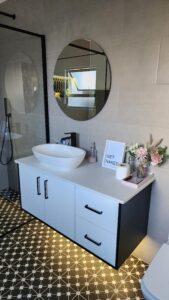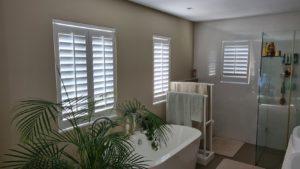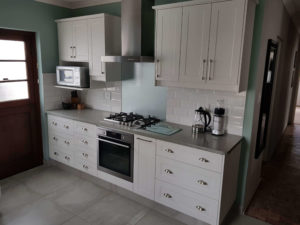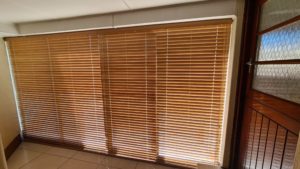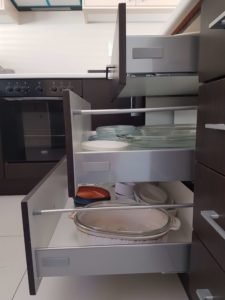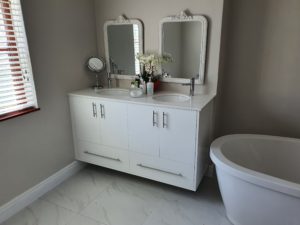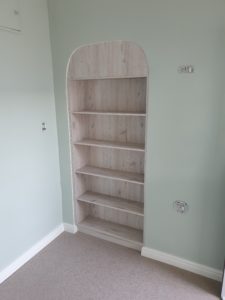Venetian blinds are a popular window treatment that can be found in homes and offices all around the world. These blinds are made up of horizontal slats that can be adjusted to control the room’s light and privacy. While they may seem like a modern invention, the history of Venetian blinds dates back centuries.
The origins of Venetian blinds can be traced back to ancient Persia, where they were used to keep out the hot sun and dust storms. Venetian traders discovered the window coverings through their trade interactions in the East and brought them back to Venice and Paris. From there, they spread throughout Europe and eventually made their way to the United States in the 18th century.
One of the earliest records of Venetian blinds in America was their installation at St. Peter’s Church in Philadelphia in 1761. John Webster, an upholsterer from London, was one of the pioneers of Venetian blinds in the United States. Over time, Venetian blinds became a popular window treatment across the continent and have remained a staple in homes and offices ever since.
The Origins of Venetian Blinds
Venetian blinds have a long and fascinating history that dates back to the 1700s. Although their early history is mostly conjectural, they are thought to have originated in Persia, not Venice. Venetian traders discovered the window coverings through their trade interactions in the East and brought them back to Venice and Paris.
The earliest Venetian blinds were made of wooden plates placed together horizontally. These early Venetian blinds were made of two-inch wooden strips that were tied together with cloth ribbons. The blinds were originally made of bamboo, but as their popularity grew, they were made of other materials, including wood and metal. It wasn’t until 1769 that the first Venetian blind was patented by an Englishman named Edward Bevan. By the 18th century, Venetian blinds were installed in St. Peter’s Church in Philadelphia, marking their arrival in the United States.
The Popularity of Venetian Blinds in Europe
Venetian Blinds in France
Venetian blinds quickly became popular in France after their introduction to Europe in the 18th century. The French were captivated by the elegant and functional design of the blinds, which allowed for precise control of light and privacy. Venetian blinds were particularly popular in Parisian homes, where they were often used in conjunction with sheer curtains to create a layered and sophisticated look.
By the 19th century, Venetian blinds had become a staple of French interior design. They were used in a variety of settings, from grand chateaus to modest apartments. The popularity of Venetian blinds in France continued well into the 20th century, with many homes still featuring the classic window treatment today.
Venetian Blinds in England
Venetian blinds also found a receptive audience in England. They were first introduced to the country in the late 18th century and quickly gained popularity among the upper classes. Venetian blinds were seen as a luxurious and stylish addition to any home, and were often used in formal drawing rooms and dining rooms.
As the 19th century progressed, Venetian blinds became more widely available and affordable, and their use spread to middle-class homes. By the early 20th century, Venetian blinds had become a common sight in homes throughout England. They were often used in conjunction with heavy drapes or curtains to provide insulation and privacy.
Today, Venetian blinds remain a popular window treatment in England and are available in a wide range of styles and materials to suit any decor.
The Spread of Venetian Blinds to America
Venetian blinds were first introduced to America in the late 18th century. They were initially used in commercial buildings and gradually made their way into homes.
Venetian Blinds in the United States
In 1841, John Hampson, an inventor from New Orleans, created a mechanism that allowed the slats within the blinds to be adjusted. This innovation made Venetian blinds even more popular in the United States. By the early 20th century, Venetian blinds were widely adopted in American homes and offices as a practical and stylish window treatment.
The popularity of Venetian blinds in the United States continued to grow throughout the 20th century. In the 1930s, the Rockefeller Center’s RCA Building, better known as Radio City, adopted Venetian blinds. They became a common fixture in American homes during the post-World War II housing boom.
Venetian Blinds in Canada
Canada also saw the rise of Venetian blinds in the 20th century. In the 1920s and 1930s, Venetian blinds were widely used in Canadian homes and commercial buildings. They were favoured for their ability to regulate light and air, making them a practical choice for the harsh Canadian climate.
Today, Venetian blinds remain a popular window treatment in both the United States and Canada. They are available in a variety of materials, including wood, aluminium, and vinyl, and can be customized to fit any window size or shape.
Modern Venetian Blinds
Materials Used Today
Modern Venetian blinds are made of various materials, including wood, aluminium, vinyl, and composite materials. Wooden Venetian blinds are still popular and come in a range of finishes, including natural wood stains and painted finishes. Aluminum Venetian blinds are lightweight and durable, and they come in a range of colours and finishes. Vinyl Venetian blinds are low-maintenance and easy to clean, making them a popular choice for high-traffic areas. Composite materials, such as faux wood (Plaswood), are also used in the construction of Venetian blinds.
Variations in Design
Today’s Venetian blinds come in various designs to fit any decor style. Some of the most popular variations include:
- Wide slats: These are a popular choice for a more modern look and allow more light to enter the room when the slats are open.
- Narrow slats: These are a more traditional option and provide more privacy when the slats are closed.
- Cloth tapes: These are a decorative addition to Venetian blinds and can be used to add a pop of colour or pattern to the blinds.
- Motorized: Motorized Venetian blinds are a convenient option for hard-to-reach windows and can be controlled with a remote or a smartphone app.
Overall, modern Venetian blinds continue to be a popular window treatment option due to their versatility, durability, and timeless style.
Conclusion
Venetian blinds have a long and fascinating history, originating in Persia and gaining popularity throughout Europe in the 18th century. Their durability, ease of use, and affordability made them a popular choice for both residential and commercial settings. Today, Venetian blinds continue to be a popular window treatment option, with a wide variety of styles and materials available to suit any taste or budget. From traditional wooden blinds to modern aluminium or vinyl options, there is a Venetian blind to fit any decor. While their popularity may have waxed and waned over the years, Venetian blinds remain a classic choice for anyone looking for a versatile and stylish window treatment. Whether you’re looking to add privacy, control light, or simply enhance the look of your home or office, Venetian blinds are a timeless option that will never go out of style.
If you are in need of a new set of blinds or curious about the blind installations we provide, please contact us today to learn more.






